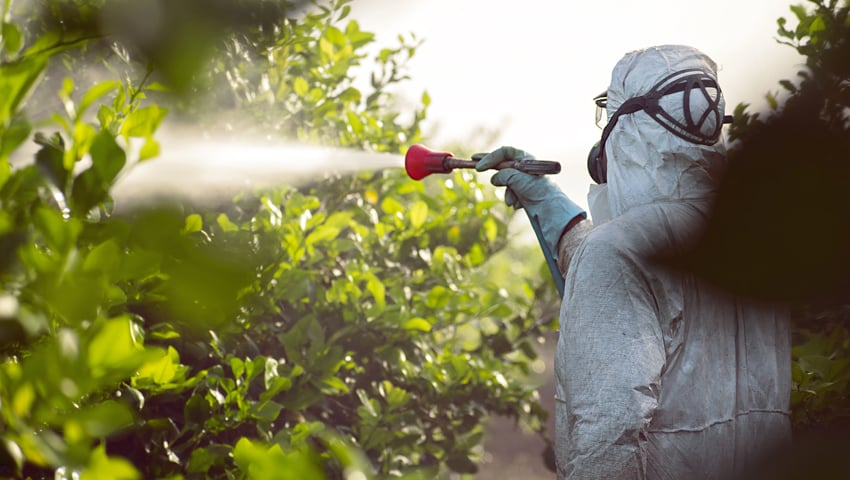IN A joint report released today, the NGOs Générations Futures and Pesticide Action Network (PAN) Europe shed light on a previously overlooked concern: a specific category of pesticide active ingredients that are officially recognized as ‘PFAS’ or Per- and Polyfluoroalkyl Substances.
Since the release of the film Dark Waters, PFAS, often referred to as “forever chemicals,” have become a growing concern for the general public. Their significant persistence in the environment has made them an especially worrying group of substances, prompting the European Union to propose to restrict their use and phase them out. However, pesticides have been left out of the regulatory proposal. These substances, which are widely used in agriculture, are clearly identified as hazardous molecules for health and the environment. Many people are unaware that pesticide active ingredients can be PFAS, or that products formulated with pesticides can contain PFAS. That’s what we’re revealing today in a report that details the scale of the situation.
Angeliki Lysimachou, Head of Science and Policy at PAN Europe, said, “It is shocking to find that PFAS, with their long-lasting environmental impacts, are intentionally sprayed on fields and food. Given all the identified risks, their use should stop immediately.”
The report’s findings
Unlike PFAS pollution resulting from industrial leaks via atmospheric emissions or aqueous effluents, these PFAS pesticides are widely used and deliberately sprayed directly into the environment.
PFAS pesticides are used as active substances to enhance their stability, which, in turn, keep them effective longer.
In Europe: 37 active substances currently approved for use in pesticides are PFAS, representing 12% of all approved synthetic substances.
In France: 30 PFAS pesticide active substances are currently authorised, i.e. 13% of all synthetic substances authorised. Their sales have more than tripled since 2008. In 2021, 2332 tonnes of PFAS active substances will be sold in France.
Why are these substances problematic?
Based on an analysis of the authorisation dossiers for the 10 PFASs with the highest sales in France, we can confirm that the vast majority of these substances are persistent in the environment or give rise to persistent metabolites like TFA (Trifluoroacetic acid). This means that there is a significant risk of accumulation of these chemicals in the environment from repeated use in agriculture. In addition to being persistent these substances have other toxic properties that give rise to concerns for their impact on the environment and/or human health, while unacceptable risks have been identified by health authorities for several of them.
PFAS and European Regulation
The EU currently has an ambitious plan to restrict the use of PFAS in Europe, but PFAS pesticides have been excluded from the scope of this restriction.
The main argument is that these substances are already covered and sufficiently regulated under the Pesticides Regulation.
According to the Pesticides Regulation, pesticides authorised in the EU should cause no adverse effects to humans and no unacceptable effects on the environment.
However, as our report reveals, the Regulation is not implemented in practice and harmful pesticides such as PFAS continue to get approved for use in the production of our food.
The assessment carried out by health authorities has many shortcomings, allowing these substances of very high concern to be authorised:
- Persistence alone is not considered a property of sufficient concern to ban pesticides
- The toxic properties of PFAS metabolites have not been thoroughly assessed
- The endocrine disrupting properties of PFAS are poorly assessed
- Cocktail effects are not assessed, even though marketed products sometimes contain several PFAS active substances
- Inadequate risk management by public health authorities:
PFAS are systematically approved or their approval is extended even when health authorities have identified unacceptable risks (“areas of critical concern”) or the risk assessment has not been completed (data gaps).
PFAS pesticide active substances that are considered “candidates for substitution” are not actually substituted and continue to be used.
The authorisation for the most used PFAS pesticide Flufenacet – a direct source of TFA in water – for example has been prolonged eight times while awaiting the results of the reassessment
Failure to apply the precautionary principle
Salomé Roynel, Policy Officer at PAN Europe, said, “It is urgent to ban this source of PFAS pollution. These pesticides should be included in the PFAS restriction currently being prepared at European level. That will take time, so we immediately need a better implementation of the pesticide regulation. We propose to apply the precautionary principle required by law and ban all PFAS pesticides now.”
